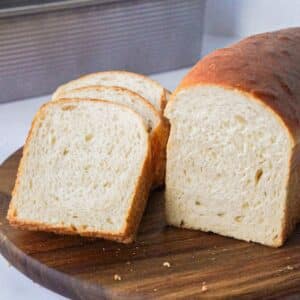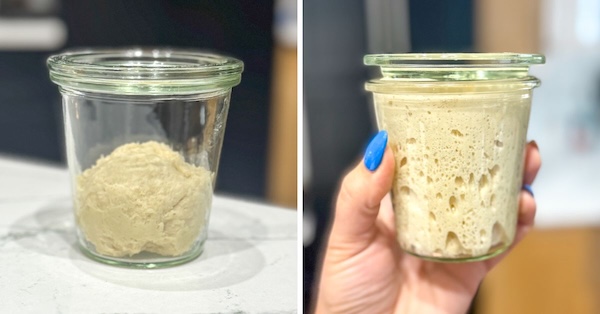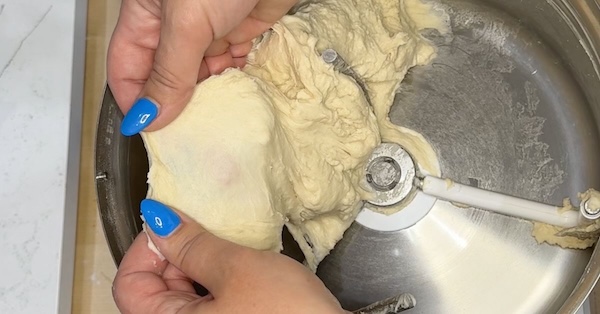Sourdough Wonder Bread Copycat Recipe
Equipment
- 13x4 long loaf pan (USA Pan is my favorite)
- Stand mixer (with dough hook)
- 2-quart bowl (for first rise)

Ingredients
Stiff Sweet Starter
- 15 g sourdough starter
- 15 g honey
- 30 g water
- 60 g bread flour
Tangzhong
- 35 g bread flour
- 175 g whole milk
Main Dough
- All of the stiff sweet starter (from above)
- All of the tangzhong (from above)
- 225 g cold water
- 75 g honey
- 25 g avocado oil
- 575 g high-protein bread flour (see Notes)
- 12 g salt
- 1 tbsp butter (for buttering the baked loaf)
Instructions
Day 1 (Evening)
- Make the stiff sweet starter: In a small jar, mix 15 g sourdough starter, 15 g honey, 30 g water, and 60 g bread flour until it forms a ball. Knead outside of the jar to fully incorporate the ingredients. Cover loosely and let ferment at room temperature until morning.

- Make the tangzhong: Mix 35 g bread flour and 175 g whole milk in a microwave-safe bowl. Microwave in 30-second intervals, stirring between each, until thickened and reaches 150°F (65°C). For me, it usually takes 3-5 rounds to finish. Cover and refrigerate until morning.

Day 2 (Morning)
- Mix the dough: In stand mixer bowl, combine All of the stiff sweet starter, All of the tangzhong, 225 g cold water, 75 g honey, 25 g avocado oil, 575 g high-protein bread flour, and 12 g salt. Mix on speed 1 (lowest speed) for 1-2 minutes until ingredients come together, then increase to speed 2 (a tiny bit faster) and mix for 10-15 minutes, or until dough reaches a weak windowpane. It takes about 10 minutes in a Bosch and upwards of 30 minutes in a KitchenAid, for reference.The dough will feel slightly sticky or tacky after mixing, but it should hold its shape. If the dough doesn't fully come together after a few minutes in the stand mixer, add additional flour in 1 tbsp increments.

- Bulk fermentation: Transfer to lightly oiled bowl, cover, and let rise on counter until evening (8-12 hours). At the end of bulk fermentation, the dough should have risen by about 40%, have lots of bubbles, and should be puffy when you tap the surface. (My BF took 11 hours; my home was 73°F/23°C and my dough was 75°F/24°C.) Once it reaches this point, put the bowl in the refrigerator until bedtime to slow down fermentation.

Day 2 (Evening)
- Shape the dough: If not using a nonstick bread pan, lightly oil it. Bring dough out of the fridge and turn it onto work surface (use a light dusting of flour to prevent sticking, if needed). Using a rolling pin, roll dough into rectangle slightly narrower than pan width (about 10" wide by 14" long).
- Roll up the dough tightly, pinch the seams on each end, and place your dough log seam-side down in bread pan.

- Second rise: Cover and let rise on the counter, overnight, until very puffy and the dough is even with the height of the pan rim (approximately 8-12 hours). (My dough was ready after 11.5 hours in a 73°F/23°C environment.)Note: If your home is warmer than about 75°F (24°C), the dough will likely overproof by morning. I advise putting it in the fridge overnight and resuming with the second rise in the morning.

Day 3 (Morning)
- Bake: Preheat oven to 350°F (175°C). Bake uncovered 40-45 minutes until internal temperature reaches 200-205°F (93-96°C). If the top of the loaf is getting too dark, cover with foil. Once done, immediately brush hot loaf with 1 tbsp butter. Cool in pan 5-10 minutes, then turn out onto rack. Cool completely before slicing (1-2 hours).
Video
Notes
Flour Options:
- Bread flour: Ballerina Farms (14% protein) or King Arthur unbleached (12.7% protein) - no adjustments needed
- All-purpose: Costco AP flour - add 25g extra flour to main dough
- Canadian options: Arva Mills Daisy flour or Boreal Organic All Purpose (Costco) work perfectly (thanks to follower Amanda Steele for this tip)
Nutrition
Serving: 1 sliceCalories: 157kcalCarbohydrates: 29gProtein: 4gFat: 3gSaturated Fat: 1gPolyunsaturated Fat: 0.4gMonounsaturated Fat: 1gTrans Fat: 0.02gCholesterol: 3mgSodium: 241mgPotassium: 50mgFiber: 1gSugar: 4gVitamin A: 33IUVitamin C: 0.02mgCalcium: 16mgIron: 0.3mg